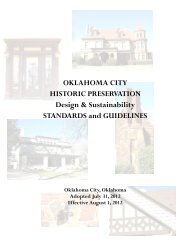OKC Plan, 2000-2020 - City of Oklahoma City
OKC Plan, 2000-2020 - City of Oklahoma City
OKC Plan, 2000-2020 - City of Oklahoma City
You also want an ePaper? Increase the reach of your titles
YUMPU automatically turns print PDFs into web optimized ePapers that Google loves.
Develop vacant parcels with appropriate infill construction that is consistent with the character<br />
<strong>of</strong> the district and differentiated from the historic fabric. This development is subject to existing<br />
historic preservation design review.<br />
Review traffic patterns and related environment with the intent <strong>of</strong> finding and implementing<br />
solutions to changing transportation needs while retaining the unique character <strong>of</strong> each historic<br />
districts.<br />
Work with building code <strong>of</strong>ficials to identify and implement alternate regulations with the intent<br />
<strong>of</strong> preserving historic structures while achieving the intent and purposes <strong>of</strong> current and future<br />
codes affecting life/safety issues.<br />
Work with <strong>City</strong> <strong>of</strong>ficials to insure that any infrastructure improvements that effect the character<br />
<strong>of</strong> the district respond to existing design guidelines.<br />
Non-Residential Buildings and Districts<br />
The character <strong>of</strong> a great city is, to many, defined by its commercial districts, particularly its<br />
downtown. Although half <strong>of</strong> <strong>Oklahoma</strong> <strong>City</strong>’s downtown core was demolished in the 1970s,<br />
significant buildings remain. Recent capital expenditures in the downtown core and Bricktown have<br />
already resulted in a noticeable increase in economic activity there.<br />
Neighborhood commercial districts are part <strong>of</strong> the identity <strong>of</strong>, and provide amenities for, their nearby<br />
residential areas. Three historic commercial districts (Stockyards <strong>City</strong>, Automobile Alley, and<br />
Capitol Hill) have established Main Street programs, utilizing organization, historic design<br />
guidelines, economic restructuring, and promotion activities.<br />
Government facilities are important visual elements in the cityscape. Included are facilities <strong>of</strong> the<br />
city, county, state, and federal governments, as well as schools. They include such diverse elements<br />
as parks, bridges, schools, dams, airports, and water works, as well as public buildings. Many <strong>of</strong><br />
these facilities retain their historic integrity.<br />
Directions<br />
Document and preserve significant historic non-residential buildings and districts.<br />
Use incentives, as well as regulations to facilitate preservation.<br />
Actions<br />
Inventory and establish design review for significant commercial, public, and educational<br />
buildings and districts.<br />
Prioritize those historic properties based on significance, integrity and endangerment.<br />
Develop local tax incentives, including business improvement districts, tax increment financing,<br />
and rebates specifically designed to serve historic preservation goals. Promote federal historic<br />
tax credits.<br />
75

















